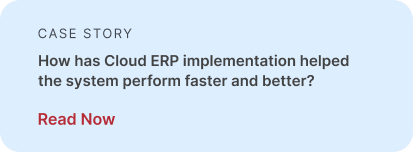ERP Procurement: ERP Solutions for Modern Procurement
Procurement is no longer just about purchasing rather it's about precision, performance, and proactive strategy. As businesses across Canada face increasing pressure to streamline operations, reduce costs, and ensure supply chain resilience, ERP software for Procurement has emerged as a transformative force.
From the bustling manufacturing hubs of Ontario to the resource-rich provinces of Alberta and British Columbia, Canadian organizations are turning to ERP system for procurement to gain real-time visibility, automate workflows, and drive smarter decision-making.
This article explores how ERP procurement is reshaping the way Canadian businesses source, manage, and pay for goods and services while ushering in a new era of digital efficiency and competitive advantage.
What is Procurement ERP?
ERP software for Procurement refers to the integration of procurement processes into an ERP system, which is a type of enterprise software used by organizations to manage and automate core business functions. In the context of purchasing, an ERP procurement module helps streamline and centralize the buying of goods and services. Microsoft Dynamics 365 ERP, SAP S/4HANA and Oracle NetSuite are some top ERPs for procurement.
Key Features of ERP Procurement:
- Supplier Management: Tracks supplier information, performance, and contracts.
- Purchase Requisition and Order Management: Automates the creation, approval, and tracking of purchase requests and orders.
- Inventory Integration: Ensures that ERP procurement process is aligned with inventory levels to avoid overstocking or stock outs.
- Invoice and Payment Processing: Links procurement with accounts payable for seamless invoice matching and payment.
- Spend Analysis: Provides insights into purchasing trends and helps identify cost-saving opportunities.
- Compliance and Risk Management: Ensures that purchases comply with internal policies and external regulations.
Benefits of Using an ERP System Procurement Approach:
- Efficiency: Reduces manual work and speeds up procurement cycles.
- Cost Control: Helps manage budgets and reduce unnecessary spending.
- Visibility: Offers real-time data on procurement activities.
- Standardization: Ensures consistent procurement practices across departments or locations.
How can Dynamics 365 help with ERP Procurement?
Microsoft ERP solutions like Dynamics 365 offer a robust platform to enhance and streamline procurement processes. With a modern ERP procurement process flow, businesses can move from manual, disconnected purchasing to a highly automated, integrated system.
Here’s an overview of how Dynamics 365 ERP addresses all the challenges of the procurement process:
End-to-End Procurement Automation
MS Dynamics automates the entire lifecycle from requisition to payment improving efficiency and transparency:
- Create and route purchase requisitions through workflow.
- Auto-generate purchase orders based on inventory or production triggers.
- Perform three-way matching (PO, invoice, receipt) to validate transactions.
Vendor and Supplier Management
Centralized vendor profiles allow better relationship management, contract tracking, and performance evaluation including key capabilities in procurement ERP software.
- Maintain detailed vendor profiles including pricing, delivery terms, and performance history.
- Use vendor evaluation tools to assess reliability, quality, and cost-effectiveness.
- Enable vendor collaboration portals for real-time communication and document sharing.
Inventory and Supply Chain Integration
ERP supply chain integration ensures real-time alignment of procurement with stock levels and forecasts:
- Monitor stock levels and trigger reorders automatically.
- Align procurement with production schedules and demand forecasts.
- Reduce stock outs and overstocking through intelligent planning.
Spend Analysis and Reporting
With Power BI integration, Dynamics 365 ERP offers in-depth procurement insights:
- Track spending by category, vendor, or department.
- Identify cost-saving opportunities and negotiate better terms.
- Monitor procurement KPIs like order cycle time, supplier lead time, and compliance rates.
Compliance and Risk Management
Ensure your ERP system procurement activities meet corporate and regulatory requirements:
- Enforce approval workflows and spending limits.
- Maintain audit trails for all transactions.
- Track and manage contracts, certifications, and regulatory requirements.
Seamless Integration with Finance and Operations
Microsoft ERP connects procurement with finance and operations so everything works together smoothly. It helps you:
- Match purchases with budgets and departments.
- Automatically update financial records when items are received.
- Track costs accurately for project-related purchases.
In summary, Dynamics 365 ERP transforms procurement into a strategic function, enabling organizations to reduce costs, improve supplier relationships, and ensure operational continuity.
How can Business Central improve your purchasing processes?
Business Central transforms traditional purchasing into a streamlined, data-driven process. It connects purchasing with inventory, finance, and vendor management, enabling businesses to make faster, more informed decisions.
Efficient Purchase Order Management
Instead of manually tracking orders and invoices, Business Central allows you to create, approve, and monitor purchase orders in a centralized system. You can generate POs directly from sales orders or inventory needs, reducing delays and errors.
- Automatically convert purchase requisitions into POs.
- Track order status, expected delivery dates, and vendor commitments in real time.
Automated Replenishment and Inventory Planning
Business Central uses inventory thresholds, lead times, and demand forecasting to suggest when and what to reorder. This ensures you maintain optimal stock levels without over-purchasing.
- Set reorder points and safety stock levels.
- Use planning worksheets to review and approve suggested purchases.
Vendor Relationship Management
Managing vendors becomes easier with detailed profiles that include pricing, payment terms, and performance history. You can compare vendors and select the best fit for each purchase.
- Store and track vendor contracts and agreements.
- Evaluate vendor performance based on delivery times and quality.
Cost Control and Budget Alignment
With built-in budgeting tools, Business Central helps you control spending and avoid budget overruns. Approval workflows ensure that only authorized purchases go through.
- Set up multi-level approval chains.
- Monitor actual vs. budgeted spend in real time.
Insightful Reporting and Analytics
Business Central integrates with Power BI to provide rich visual dashboards and reports. These insights help you analyze purchasing trends, identify cost-saving opportunities, and improve supplier negotiations.
- View spend by category, vendor, or department.
- Track procurement KPIs like order cycle time and vendor reliability.
Seamless Integration Across Departments
Purchasing doesn’t operate in a silo. Business Central connects procurement with finance, inventory, sales, and projects, ensuring that every purchase aligns with broader business goals.
- Automatically update inventory and financial records upon receipt of goods.
- Link purchases to specific projects or cost centers.
Ready To Transform Your Procurement Process
With the growing pace of digital transformation, outdated purchasing systems simply can't keep up. A modern ERP procurement module offers automation, transparency, and strategic control.
Microsoft ERP solutions like Dynamics 365 centralize your procurement workflows and improve efficiency. Whether you need warehouse management system integration or vendor analytics, Dynamics 365 adapts to your goals.
Dynamics 365 ERP solves procurement challenges by automating processes, improving visibility, and connecting procurement with finance, inventory, and projects.
Why Canadian Businesses Choose Dynamics Square Canada
At Dynamics Square Canada, we specialize in delivering Dynamics 365 implementation for manufacturers, distributors, and service-based businesses. From ERP system procurement to full ERP supply chain integrations, our team brings deep industry knowledge and local expertise. Whether you're in Ontario, Alberta, British Columbia, or Quebec we’ve got you covered.
What You Will Gain:
- Real-time ERP procurement process flow visibility
- Integrated warehouse management system support
- Optimized vendor management with procurement ERP software
- Seamless coordination across inventory, finance, and operations
- Support for Canadian tax rules, compliance, and bilingual environments
Let’s Get Started
Upgrade your procurement with Microsoft ERP backed by a trusted partner. Book your free consultation with Dynamics Square Canada and experience the power of ERP system for procurement in action.
If you need any help, don't hesitate to reach out to us. You can give us a call at +1 289 807 0740 or send us an email at info@dynamicssquare.ca.
People Also Ask:
What is ERP procurement meaning?
It refers to managing procurement processes through an ERP system, including purchasing, vendor management, and payment integration.
How does ERP work in procurement?
ERP systems support procurement by:
- Automating purchase requisitions and orders
- Managing supplier databases and contracts
- Tracking inventory levels and delivery schedules
- Integrating with accounts payable for seamless invoicing and payments
- Providing real-time analytics for better decision-making
What are the 3 common types of ERP?
- On-Premise ERP: Installed locally on a company’s servers.
- Cloud ERP: Hosted on the vendor’s cloud platform, accessible via the internet.
- Hybrid ERP: Combines on-premise and cloud features for flexibility.
What is the ERP procurement process?
It includes identifying needs, creating requisitions, approving and issuing purchase orders, receiving goods, and processing payments, all tracked within a unified ERP system.
What is ERP in supply chain?
ERP in the supply chain refers to using ERP software to manage and optimize the flow of goods, information, and finances across the supply chain. It helps with:
- Demand forecasting
- Inventory management
- Supplier coordination
- Logistics and distribution
- Real-time tracking and reporting
What are the 4 types of procurement?
- Direct Procurement: Buying raw materials for production.
- Indirect Procurement: Purchasing goods/services not directly tied to production (e.g., office supplies).
- Goods Procurement: Acquiring physical items.
- Services Procurement: Hiring external services (e.g., consulting, maintenance).
What are the 7 stages of procurement?
- Identify Needs
- Specify Requirements
- Supplier Sourcing
- Request for Proposal (RFP)/Quotation (RFQ)
- Evaluate and Select Supplier
- Purchase Order and Contracting
- Delivery, Inspection, and Payment
What is ERP in payments?
ERP in payments refers to the integration of payment processing within the ERP system. It automates:
- Invoice generation
- Compliance with tax and audit requirements
- Payment approvals
- Vendor payments
- Reconciliation with financial records



